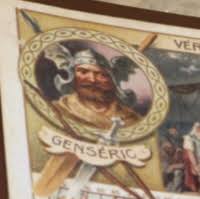Editors’ note: Footnotes have been omitted. To contextualise this section of Vol. II of Karlheinz Deschner’s encyclopaedic history of the Church in 10 volumes, Kriminalgeschichte des Christentums, see the abridged translation of Volume I (PDF: here, hard copy: here), which reproduces a syntactically corrected edition of instalments 1-100 on this site. Instalments 101-122 can also be read on this site.
The Vandal state
 Gaiseric created the first independent Germanic state on Roman soil. This Germanic state had its richest and most fertile provinces: Mauretania Tingitana, Africa Zeugitana, Byzacena and Numidia Proconsularis. Gaiseric also became the owner of Corsica and Sardinia, whose forests were cut down by workers under forced labour to build his ships. By 455 he added the Balearic Islands, which he had already sacked in 425. He dominated the seas from Gibraltar to Constantinople and did not even give nominal recognition to the Byzantine emperor, although in pledge of peace he had to send his son Huneric to Italy. […]
Gaiseric created the first independent Germanic state on Roman soil. This Germanic state had its richest and most fertile provinces: Mauretania Tingitana, Africa Zeugitana, Byzacena and Numidia Proconsularis. Gaiseric also became the owner of Corsica and Sardinia, whose forests were cut down by workers under forced labour to build his ships. By 455 he added the Balearic Islands, which he had already sacked in 425. He dominated the seas from Gibraltar to Constantinople and did not even give nominal recognition to the Byzantine emperor, although in pledge of peace he had to send his son Huneric to Italy. […]
The rich churches and monasteries were sacked, as they were ‘bastions of Roman domination’ (Diesner). It is understood that, in general, the Catholic civilian population offered no resistance anywhere, remaining indifferent or sympathising with the invaders. Some of them even converted to Arianism despite Gaiseric’s attacks which were particularly brutal against clerics, monks, and nuns who were often raped. […] Occasionally, as happened after the occupation of Carthage, the king appropriated all the property, furniture and real estate of the adversary clergy. He also ordered that all churches be closed, handed over to the Arian clergy and used as barracks. […]
As comprehensible as the outrage of the Catholic chroniclers against Gaiseric is, one of them at least concedes something. The Father of the Salvian Church of Marseille praises Gaiseric’s fight against ‘impurity’. Well, this blood-stained Christian was tremendously puritan: a very frequent combination, as we know. He not only fought against pederasty but also against brothels, even forcing all prostitutes to marry.
The king of the Vandals, who, if necessary, was not intimidated by any bloody action, experiences such disgust at the plague of public sexual lewdness—a plague characteristic of the big cities—, and considers it such an abomination for his compatriots, that he proposed to eradicate it from end to end. And everything indicates that he achieved it while he lived.
The history of the Vandal State has only been bequeathed to us, almost exclusively, by Catholic clerics. Even the few historical testimonies of a profane nature are strongly influenced by them. Therefore, it is more than likely to have been distorted by their biases […]. Despite all the exaggerations, even falsifications, of the history by the Catholic tradition, there can be no doubt that the proceeding of Gaiseric towards the Catholic clergy was very tough and sometimes bloodthirsty. That clergy was, of course, not only a bitter adversary of Arianism. Arianism increasingly became an enemy of the State. […]
Gaiseric died very old at the beginning of the year 477. His son and successor was Huneric (477-484), whose wife, daughter of Valentinian III to which Gaiseric abducted from Rome in 455, fled in 472 to Jerusalem: presumably by aversion to her husband’s Arian faith […]. Huneric succumbed early, in December of the year 484, victim of a disease. The Catholics welcomed the news joyfully as every time one of their adversaries dies.
One reply on “Christianity’s Criminal History, 123”
Reblogged this on My Jorney.